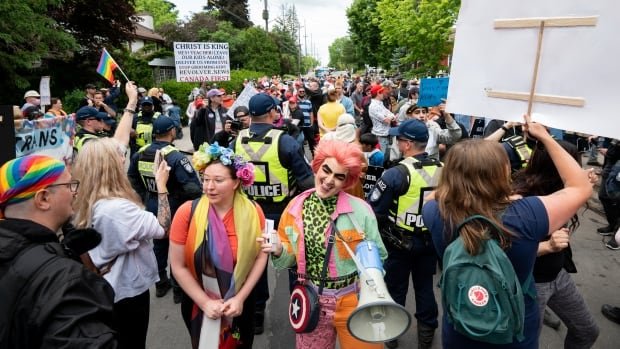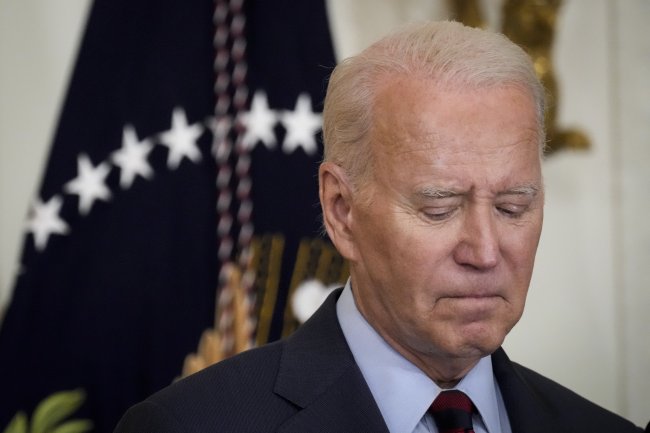As gender protests move closer to students, is it time for 'bubble zones' outside of schools?
Protesters in support of Pride celebrations and LGBTQ rights are seen during a rally in Ottawa's west end on June 9. (Spencer Colby/The Canadian Press)As gender-related policies in schools draw debate, some are calling for "safe zones" to be established around schools to allow students to remain focused on education.Safe zones — also known as bubble zones — effectively create a perimeter around institutions by either limiting or prohibiting certain activities, like protests, in a defined area.It comes after hundreds of protesters and counter-protesters swarmed the streets outside of three schools in Ottawa last month, rallying on opposite sides over how gender identity is taught. At least one school went under a lockdown for the day.In response, Ottawa-Carleton District School Board (OCDSB) trustee Dr. Nili Kaplan-Myrth has suggested that one way to combat such disruptions could be to criminalize protests that violate Ontario's human rights code near schools."There should be a law aga

As gender-related policies in schools draw debate, some are calling for "safe zones" to be established around schools to allow students to remain focused on education.
Safe zones — also known as bubble zones — effectively create a perimeter around institutions by either limiting or prohibiting certain activities, like protests, in a defined area.
It comes after hundreds of protesters and counter-protesters swarmed the streets outside of three schools in Ottawa last month, rallying on opposite sides over how gender identity is taught. At least one school went under a lockdown for the day.
In response, Ottawa-Carleton District School Board (OCDSB) trustee Dr. Nili Kaplan-Myrth has suggested that one way to combat such disruptions could be to criminalize protests that violate Ontario's human rights code near schools.
"There should be a law against [protesting outside schools] because we protect students, staff and all members of the community from any form of hatred," she said.
"There were people who were going to do a bigoted protest at the human rights monument in Ottawa and it was cancelled. Why? Because they couldn't get a permit from the city."
Kaplan-Myrth — a family physician who says she experienced harassment and death threats during the COVID-19 pandemic — recently wrote an op-ed about safe zones in the Ottawa Citizen; a petition in support of them on Change.org has also been signed by more than 2,500 people.
For Kaplan-Myrth, legislation aimed at safety could prompt more efficient enforcement around schools.
Students peeking through school windows in Ottawa during the duelling protests on June 9 said they were witness to the violence and five police arrests. Counter-protestors have said some of the demonstrators hurled transphobic slogans, and images from the protests show some stomping on Pride flags.
One 16-year-old non-binary student from a nearby high school, who asked not to be named out of fear of being targeted, said they're worried anti-LGBTQ protests have become the norm in Canada.
"I was scared, but it was not something new because, especially at my school, things like that happen almost every day."

The student said the sight of anti-LGBTQ billboards and messages in front of a school has an impact on their education.
"In situations like that, I often find myself just going home and staying home, because I don't feel comfortable being at school or being out of the house," they said.
Across Canada, demonstrations and events seen as anti-LGBTQ are finding new ground, experts say.
In April, a youth-led anti-trans group called Save Canada disrupted an International Day of Pink event at a school in Toronto. In May, Halifax saw what's been called hate-motivated vandalism of Pride flags at some of its schools. And last month, a St. John's school faced backlash and online vitriol through "threats, demeaning language and accusations" for holding an event celebrating Pride.
Evan Balgord, executive director of the Canadian Anti-Hate Network, says demonstrations near schools have grown exponentially in the last five years.
"Adults were not holding demonstrations in front of schools where there are children and teenagers as often. So that's a change and it's not a good one," he said.
Figures from Statistics Canada also show an uptick in reported hate crimes targeting people for their sexual orientation, from 176 police-reported incidents in 2016, to 423 in 2021.
However, these statistics are almost certainly underestimated due to instances of underreporting, says the LGBTQ advocacy group, Egale. It says there were over 6,400 instances of online hate and anti-LGBTQ protests between January and March of 2023.
Policy discussed during COVID-19
There is no real precedent in Canada for safe zones near schools, but recent legislation suggests it could potentially be done.
In September 2021, thousands joined in anti-vaccine protests outside hospitals and schools in B.C., prompting representatives of health-care workers and school principals to ask for protest-exclusion zones around key institutions.
Later, federal and provincial leaders condemned the protests, and Prime Minister Justin Trudeau promised to make it a criminal offence to block access to buildings that provide health care.
Federal Bill C-3, amended in 2021, now safeguards hospitals and clinics against harassment of health-care professionals. The law applies to protesters at any health-care facility, including those that provide abortion. It also applies to any health-care professional in any location where they are harassed, including their homes or online.
Cheshmak Farhoumand-Sims, a parent of four school-aged children in Ottawa, sees bubble zones as a way to safeguard all schools against potentially hateful and disruptive protests.
"Today, they're going to be at that school. Tomorrow, they'll be at another school. Three weeks later, it might be at my kids' school," she said.
Farhoumand-Sims says protesters use the rhetoric that it is their right to protest as a form of free speech and expression. But she argues her children have a right to education.
"My children have the right to have an ability to go at recess and not be under shelter in place. So whose rights here are more important than the others?"
Why some see 'safe zones' as not ideal
Some community groups are concerned such safe zones will only increase police presence near schools. Instead, they want authorities to listen to local LGBTQ groups and organize counter-protests as better options to warrant safer environments.
After the Ottawa protests, a community group of activists, organizers and local labour unions issued a statement talking about their experience on June 9. To them, more laws and enforcement is worrying.
"We remember the feeling of being tackled and crushed to the ground by officers with hands on their guns, of being bruised and bloodied and denied our rights. We already have laws in place that are supposed to protect us from the violent attacks we endured, but these were not used to protect us," the statement reads.
Emily Quaile, a parent of a student at one of the schools targeted in Ottawa who helped organize the counter-protests, says it was the counter-protesters who kept the original group from reaching the school grounds. But, Quaile said, four of the five arrests were actually from their group.
"We kept them from schools using human blockade and peaceful manoeuvres. So that's a huge win," she said. "What we were fighting against wasn't just those fascists, we were also fighting the police."
Quaile says she believes existing laws should have been enough to stop the Ottawa protests. "The Human Rights Code is a charter of rights that has a thing about hate speech — and that's rarely enforced," she said.
Balgord shares similar concerns.
"If a city or a province is going to enact laws like this, they need to be so careful with the wording, so the law enforcement cannot misinterpret the law and use it against the very people that it is supposed to protect," he said.
Instead of funding the police, another option could be more funding for queer and trans organizations to help them take on the work on ground, said Gary Kinsman, a sociology professor and the author of The Regulation of Desire and co-author of The Canadian War on Queers.
"[The government] could give lots of money for popular education about the forms of oppression young trans people are facing or why trans people or drag performers are fully within their rights to be present within the high schools," he said.
As for the 16-year-old non-binary student, they believe the idea of safe zones will help curtail potentially transphobic protests, but are also concerned it could also be used as a blanket sledgehammer to curb dissent on "legitimate" protests, like asking for higher wages for teachers.
Ultimately, though, they said, the recent protests can make students from marginalized groups feel like they don't belong in schools.
"No one should ever have to be scared when they wake up and go to school, because school should be somewhere where you learn, not where you fight."
In a memo at the beginning of Pride month, Ontario's Ministry of Education said it is incumbent on all school boards to ensure all students – especially LGBTQ students – feel supported, reflected in their schools and welcomed within communities.
In an email, OCDSB's media relations team directed CBC News to two news releases that said schools should not be the target of political protests and extended thanks to parents and police for their support through the recent demonstrations.
"It's clear there is more work to be done to promote human rights and to share information about the way these issues are managed in schools. We remain committed to working with the community and to engaging in dialogue on these issues," it read.
What's Your Reaction?


















